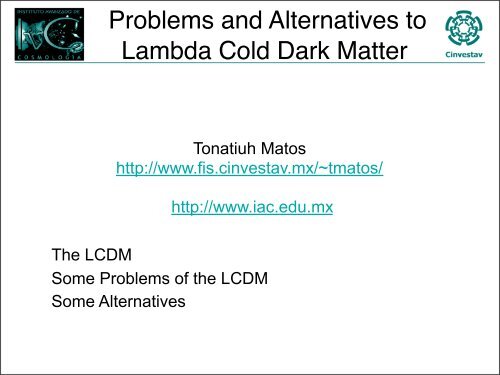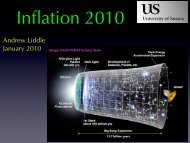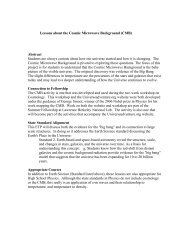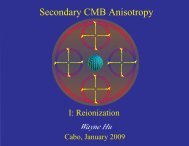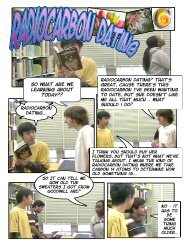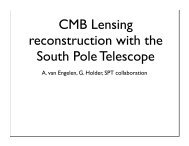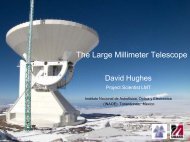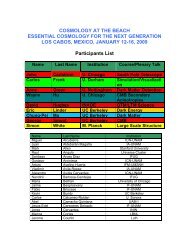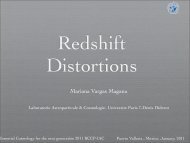Problems and Alternatives to Lambda Cold Dark Matter - Berkeley ...
Problems and Alternatives to Lambda Cold Dark Matter - Berkeley ...
Problems and Alternatives to Lambda Cold Dark Matter - Berkeley ...
You also want an ePaper? Increase the reach of your titles
YUMPU automatically turns print PDFs into web optimized ePapers that Google loves.
<strong>Problems</strong> <strong>and</strong> <strong>Alternatives</strong> <strong>to</strong><br />
<strong>Lambda</strong> <strong>Cold</strong> <strong>Dark</strong> <strong>Matter</strong><br />
Tonatiuh Ma<strong>to</strong>s<br />
http://www.fis.cinvestav.mx/~tma<strong>to</strong>s/<br />
http://www.iac.edu.mx<br />
The LCDM<br />
Some <strong>Problems</strong> of the LCDM<br />
Some <strong>Alternatives</strong>
• Space-time: FLRW<br />
• <strong>Matter</strong>: DM (p = 0), DE (p = -ρ), b (p = 0),<br />
rad (p = 1/3 ρ), ν (p = 1/3 ρ), etc.
• Space-time: FLRW<br />
• <strong>Matter</strong>: DM (p = 0), DE (p = -ρ), b (p = 0),<br />
rad (p = 1/3 ρ), ν (p = 1/3 ρ), etc.<br />
• Inflation<br />
• BBN<br />
• CMB<br />
• Structure formation<br />
The St<strong>and</strong>ard Model of<br />
Cosmology: LCDM
The St<strong>and</strong>ard Model of<br />
Cosmology: LCDM
The St<strong>and</strong>ard Model of<br />
Cosmology: LCDM<br />
4
The St<strong>and</strong>ard Model of<br />
Cosmology: LCDM<br />
CDM Paradigme<br />
• 1.- The DM fluctuation spectrum at recombination is detemined by a small<br />
number of physical paramenters.<br />
4
The St<strong>and</strong>ard Model of<br />
Cosmology: LCDM<br />
CDM Paradigme<br />
• 1.- The DM fluctuation spectrum at recombination is detemined by a small<br />
number of physical paramenters.<br />
• 2.- After recombination, the amplitude of the baryonic fluctuations rapidly<br />
grows <strong>to</strong> match that of the DM fluctuations.<br />
4
The St<strong>and</strong>ard Model of<br />
Cosmology: LCDM<br />
CDM Paradigme<br />
• 1.- The DM fluctuation spectrum at recombination is detemined by a small<br />
number of physical paramenters.<br />
• 2.- After recombination, the amplitude of the baryonic fluctuations rapidly<br />
grows <strong>to</strong> match that of the DM fluctuations.<br />
• 3.- Smaller-mass fluctutions grow <strong>to</strong> nonlineartity <strong>and</strong> virialize <strong>and</strong> then are<br />
hirarchically clustered within successively larger bound systems.<br />
4
The St<strong>and</strong>ard Model of<br />
Cosmology: LCDM<br />
CDM Paradigme<br />
• 1.- The DM fluctuation spectrum at recombination is detemined by a small<br />
number of physical paramenters.<br />
• 2.- After recombination, the amplitude of the baryonic fluctuations rapidly<br />
grows <strong>to</strong> match that of the DM fluctuations.<br />
• 3.- Smaller-mass fluctutions grow <strong>to</strong> nonlineartity <strong>and</strong> virialize <strong>and</strong> then are<br />
hirarchically clustered within successively larger bound systems.<br />
10 8−12 M⊙<br />
• 4.- Ordinary matter in bound systems of <strong>to</strong>tal mass cools rapidly<br />
enough within the DM halos <strong>to</strong> form galaxies, while larger mass fluctutations<br />
form clusters<br />
4
z=18.3<br />
The St<strong>and</strong>ard Model of<br />
Cosmology: LCDM
z=18.3<br />
The St<strong>and</strong>ard Model of<br />
Cosmology: LCDM
z=5.7<br />
The St<strong>and</strong>ard Model of<br />
Cosmology: LCDM
z=1.4<br />
The St<strong>and</strong>ard Model of<br />
Cosmology: LCDM
z=0<br />
The St<strong>and</strong>ard Model of<br />
Cosmology: LCDM
The St<strong>and</strong>ard Model of<br />
Cosmology: LCDM
The St<strong>and</strong>ard Model of<br />
Cosmology: LCDM
The St<strong>and</strong>ard Model of<br />
Cosmology: LCDM<br />
7
The St<strong>and</strong>ard Model of<br />
Cosmology: LCDM<br />
Ωχ h 2 = 3 × 10−27 cm 3 s −1<br />
σv<br />
σv ∼ 3 × 10 −26 cm 3 s −1<br />
7
C<strong>and</strong>idates:<br />
Axions<br />
Sterile neutrinos<br />
MSSM: neutralino,<br />
gravitino, etc.<br />
The St<strong>and</strong>ard Model of<br />
Cosmology: LCDM<br />
Ωχ h 2 = 3 × 10−27 cm 3 s −1<br />
σv<br />
σv ∼ 3 × 10 −26 cm 3 s −1<br />
7
C<strong>and</strong>idates:<br />
Axions<br />
Sterile neutrinos<br />
MSSM: neutralino,<br />
gravitino, etc.<br />
The St<strong>and</strong>ard Model of<br />
Cosmology: LCDM<br />
Ωχ h 2 = 3 × 10−27 cm 3 s −1<br />
σv<br />
σv ∼ 3 × 10 −26 cm 3 s −1<br />
Observations:<br />
1.- Detection of products of<br />
annihilation or decay of these particles<br />
2.-Interactions with nuclei in<br />
underground detec<strong>to</strong>rs<br />
7
Dama/Libra<br />
8
Dama/Libra<br />
8
But a light WIMP, (10-100GeV,<br />
CoGeNT collaboration) is in<br />
tension with the first<br />
XENON100 results.<br />
Aprile, E. et al. First dark matter results from the<br />
XENON100 experiment. arXiv:1005.0380.<br />
Dama/Libra<br />
8
• 1 km 3 Antartic ice with<br />
• Fo<strong>to</strong>electric sensors<br />
• Ready in 2011
IceCube Neutrino Telescope in Antartic<br />
• 1 km 3 Antartic ice with<br />
• Fo<strong>to</strong>electric sensors<br />
• Ready in 2011
ANTARES –Telescopio de Neutrinos en el<br />
Mediterraneo
ANTARES –Telescopio de Neutrinos en el<br />
Mediterraneo<br />
11
γ<br />
χχ → γγ
Telescopio HESS,<br />
Namibia (2004)<br />
γ<br />
rays satellites<br />
GLAST Satellite<br />
Start 11. Juni 2008<br />
χχ → γγ<br />
MAGIC I, II(const), La Palma
LHC<br />
LHC in CERN (Genf)<br />
2009
SuperCDMS 1TG<br />
Lux (3 T liq Xe)<br />
Xenon 1T<br />
Xenon 100<br />
Direct search<br />
of WIMP’s<br />
Gianfranco Ber<strong>to</strong>ne, Nature,468(2010)389<br />
CDMS II<br />
4 parameters<br />
7 parameters
SuperCDMS 1TG<br />
Lux (3 T liq Xe)<br />
Xenon 1T<br />
Xenon 100<br />
Direct search<br />
of WIMP’s<br />
Gianfranco Ber<strong>to</strong>ne, Nature,468(2010)389<br />
CDMS II<br />
4 parameters<br />
7 parameters
The St<strong>and</strong>ard Model of<br />
Cosmology: <strong>Problems</strong><br />
• Extreme fine tuning<br />
• Coincidence<br />
• Cuspy central density profiles<br />
• Missing Satellites Problem<br />
• No-fit of the early assembly of galaxies<br />
• Galaxies seems <strong>to</strong> be simpler<br />
• Voids are <strong>to</strong>o empty<br />
• No-detection of DM<br />
• etc.
The St<strong>and</strong>ard Model of<br />
Cosmology: <strong>Problems</strong><br />
• Cuspy central density profiles<br />
• Missing Satellites Problem<br />
• No-fit of the early assembly of galaxies<br />
• Galaxies seems <strong>to</strong> be simpler<br />
• Voids are <strong>to</strong>o empty<br />
• No-detection of DM<br />
• etc.
Galaxy´s density<br />
Observed<br />
Theory<br />
ρNFW = 1<br />
x<br />
ρNFW ∼ 1<br />
x<br />
ρ ∼ 1<br />
x α<br />
0 < α < 1<br />
δ0ρ0<br />
(1 + x) 2<br />
17
Galaxy’s Density<br />
Galaxy´s density<br />
Observed<br />
Theory<br />
ρNFW = 1<br />
x<br />
ρNFW ∼ 1<br />
x<br />
ρ ∼ 1<br />
x α<br />
0 < α < 1<br />
δ0ρ0<br />
(1 + x) 2<br />
17
W. J. G. de Blok, Stacy S. McGaugh, Albert Bosma, <strong>and</strong> Vera C. Rubin. ApJ Letters 552(2001)L24<br />
18
Galaxy’s Center: Observations<br />
W. J. G. de Blok, Stacy S. McGaugh, Albert Bosma, <strong>and</strong> Vera C. Rubin. ApJ Letters 552(2001)L24<br />
18
Galaxy’s Center: Observations<br />
Joshua D. Simon, Alber<strong>to</strong> D. Bolat<strong>to</strong>, Adam Leroy, <strong>and</strong> Leo Blitz, astro-ph/0310193<br />
19
NFW<br />
Galaxy’s Center: Observations<br />
20
Galaxy’s Center: Simulations
Galaxy’s Center: Simulations<br />
F. Goberna<strong>to</strong>, et. al., NATURE, Vol 463, 14 January 2010
Galaxy’s Center: Simulations<br />
F. Goberna<strong>to</strong>, et. al., NATURE, Vol 463, 14 January 2010
Galaxy’s Center: Simulations<br />
F. Goberna<strong>to</strong>, et. al., NATURE, Vol 463, 14 January 2010
Galaxy’s Center: Simulations<br />
F. Goberna<strong>to</strong>, et. al., NATURE, Vol 463, 14 January 2010<br />
General results from several samples<br />
including THINGS, HI survey of uniform<br />
<strong>and</strong> high quality data, imply that Tri-axiality<br />
<strong>and</strong> non-circular motions cannot explain<br />
the CDM/NFW cusp/core discrepancy<br />
ej: J. van Eymeren, C. Trachternach, B. S. Koribalski <strong>and</strong> R.-<br />
J. Dettmar: A&A arXiv:0906.4654
No evidence for internal features<br />
or star formation that could be the<br />
result of tidal processes or star<br />
formation induced by the cluster<br />
environment.<br />
ej: Samantha J. Penny, Chris<strong>to</strong>pher J. Conselice,<br />
Sven De Rijcke <strong>and</strong> Enrico V. Held:<br />
Mon. Not. R. Astron. Soc. 393, 1054–1062 (2009),<br />
etc.<br />
Galaxy’s Center: Simulations<br />
F. Goberna<strong>to</strong>, et. al., NATURE, Vol 463, 14 January 2010<br />
General results from several samples<br />
including THINGS, HI survey of uniform<br />
<strong>and</strong> high quality data, imply that Tri-axiality<br />
<strong>and</strong> non-circular motions cannot explain<br />
the CDM/NFW cusp/core discrepancy<br />
ej: J. van Eymeren, C. Trachternach, B. S. Koribalski <strong>and</strong> R.-<br />
J. Dettmar: A&A arXiv:0906.4654
Stellar Mass Predictions<br />
Till Sawala, Qi Guo, Cecilia Scannapieco, Adrian Jenkins <strong>and</strong> Simon White. Mon. Not. R. Astron. To appear.<br />
23
Stellar Mass Predictions<br />
Till Sawala, Qi Guo, Cecilia Scannapieco, Adrian Jenkins <strong>and</strong> Simon White. Mon. Not. R. Astron. To appear.<br />
The dwarf galaxies formed in<br />
hydrodynamical simulations<br />
are almost two orders of<br />
magnitude more luminous<br />
than expected for haloes of<br />
this mass.<br />
23
Velocity predictions<br />
Jesús Zavala, et. al. The Astrophysical Journal, 700:1779–1793, 2009 August 1<br />
24
Velocity predictions<br />
Jesús Zavala, et. al. The Astrophysical Journal, 700:1779–1793, 2009 August 1<br />
The simulation with CDM predicts<br />
a steep rise in the VF <strong>to</strong>ward lower<br />
velocities; for Vmax = 35 km/s, it<br />
forecasts ∼10 times more sources<br />
than the ones observed. If<br />
confirmed by the complete<br />
ALFALFA survey, these results<br />
indicate a potential problem for the<br />
CDM paradigm<br />
24
Missing Satellites Problem
Missing Satellites Problem
Missing Satellites Problem<br />
26
Missing Satellites Problem<br />
26
Galaxies appear simpler than<br />
expected<br />
M. J. Dysney, et. al. Vol 455(2008)1082<br />
R90 ∝ R50<br />
Lg ∝ R 3 50<br />
MHI ∝ R 2 50<br />
Md ∝ Lg<br />
Σ = Lg/R 2 50 ∝ L 1/3<br />
g<br />
Whereas<br />
Lg/R 3 50<br />
Md/R 3 50<br />
∝ R50<br />
are independent of the size<br />
of the galaxy
Galaxies appear simpler than<br />
expected<br />
M. J. Dysney, et. al. Vol 455(2008)1082<br />
Such a degree of organization<br />
appears <strong>to</strong> be at odds with<br />
hierarchical galaxy formation, a<br />
central tenet of the cold dark<br />
matter model in cosmology.
Voids are <strong>to</strong>o empty<br />
P. J. E. Peebles & A. Nusser, Nature 465(2010)565<br />
28
Voids are <strong>to</strong>o empty<br />
P. J. E. Peebles & A. Nusser, Nature 465(2010)565<br />
It is not clear why objects<br />
that might have been<br />
assembled in such very<br />
different ways, from different<br />
ancestral objects, should<br />
have had evolutionary tracks<br />
that converged <strong>to</strong> show<br />
small dispersions around<br />
simple power law forms for<br />
their size–luminosity<br />
relations.<br />
Nair, P. B., van den Bergh, S. & Abraham,<br />
R. G. The environmental dependence of<br />
the luminosity-size relation for galaxies.<br />
Astrophys. J. 715, 606–622 (2010).<br />
28
Voids are <strong>to</strong>o empty<br />
P. J. E. Peebles & A. Nusser, Nature 465(2010)565<br />
In short, the general<br />
insensitivity of galaxies <strong>to</strong><br />
their environments is not<br />
expected in st<strong>and</strong>ard ideas. It<br />
would help if galaxies were<br />
more rapidly assembled, as<br />
they could then evolve as<br />
more nearly isolated isl<strong>and</strong><br />
universes.<br />
28
Early assembly of the most<br />
massive galaxies<br />
Chris A. Collins, et. al. Nature, 458(2009)603
Early assembly of the most<br />
massive galaxies<br />
Chris A. Collins, et. al. Nature, 458(2009)603<br />
This suggest a new<br />
picture in which<br />
brightest cluster<br />
galaxies experience an<br />
early period of rapid<br />
growth rather than<br />
prolonged hierarchical<br />
assembly.
Pieter G. van Dokkum et. al. NATURE, Vol 460, 6 August 2009. The Astrophysical Journal, 677:L5–L8, 2008 April 10<br />
30
Early Galaxies<br />
Compactness<br />
Pieter G. van Dokkum et. al. NATURE, Vol 460, 6 August 2009. The Astrophysical Journal, 677:L5–L8, 2008 April 10<br />
30
Early Galaxies<br />
Compactness<br />
Pieter G. van Dokkum et. al. NATURE, Vol 460, 6 August 2009. The Astrophysical Journal, 677:L5–L8, 2008 April 10<br />
z=2.3 Galaxies<br />
31
1E 0657-56, "Bullet Cluster”<br />
2006<br />
32
Clusters Collisons<br />
Mastropietro, C., & Burkert, A. 2008, MNRAS, 389, 967<br />
1E 0657-56, "Bullet Cluster”<br />
2006<br />
The morphology of X-ray maps, the height<br />
of the projected temperature jump <strong>and</strong> the<br />
displacement of the gas peaks are best<br />
simulated by 6:1 encounters with initial<br />
velocity 3000 km/s<br />
32
The only way <strong>to</strong> fit the observational data<br />
using NFW profiles would be <strong>to</strong> assume<br />
a mass ratio as small as 2.7:1, which<br />
would not reproduce X-ray data.<br />
Clusters Collisons<br />
Mastropietro, C., & Burkert, A. 2008, MNRAS, 389, 967<br />
1E 0657-56, "Bullet Cluster”<br />
2006<br />
The morphology of X-ray maps, the height<br />
of the projected temperature jump <strong>and</strong> the<br />
displacement of the gas peaks are best<br />
simulated by 6:1 encounters with initial<br />
velocity 3000 km/s<br />
32
MACS J0025.4-1222<br />
2008<br />
Clusters Collisons<br />
33
MACS J0025.4-1222<br />
2008<br />
Clusters Collisons<br />
J. Lee & E. Komatsu, ApJ, 718(2010)60<br />
33
MACS J0025.4-1222<br />
2008<br />
Clusters Collisons<br />
J. Lee & E. Komatsu, ApJ, 718(2010)60<br />
Gpc 3 /h 3<br />
With a large-volume (27 )<br />
cosmological N-body MICE simulation, the<br />
probability of finding 3000 km/s is between<br />
3.3 x 10 <strong>and</strong> 3.6 x .<br />
−11 10 −9<br />
33
Shaun A. Thomas, Filipe B. Abdalla, <strong>and</strong> Ofer Lahav. arXiv:1012.2272<br />
.<br />
.<br />
.<br />
0.55
Large scale structure anomaly<br />
Shaun A. Thomas, Filipe B. Abdalla, <strong>and</strong> Ofer Lahav. arXiv:1012.2272<br />
.<br />
.<br />
.<br />
0.55
Some <strong>Alternatives</strong><br />
SM Extentions GR Extentions
• Self-Interacting DM<br />
• Warm DM<br />
• Super Heavy DM<br />
• Self-Annihilating DM<br />
• Decaying DM<br />
• Extra Symmetries,<br />
• Repulsive DM<br />
• Fuzzy DM<br />
• k-essence<br />
• Scalar Field DM<br />
(BEC DM), etc.<br />
Some <strong>Alternatives</strong><br />
SM Extentions GR Extentions
• Self-Interacting DM<br />
• Warm DM<br />
• Super Heavy DM<br />
• Self-Annihilating DM<br />
• Decaying DM<br />
• Extra Symmetries,<br />
• Repulsive DM<br />
• Fuzzy DM<br />
• k-essence<br />
• Scalar Field DM<br />
(BEC DM), etc.<br />
Some <strong>Alternatives</strong><br />
SM Extentions GR Extentions<br />
• Scalar Field DM (BEC DM)<br />
• MOND -> MOND+<br />
• f(R)<br />
• Extra Dimensions<br />
• etc.
SM Extentions GR Extentions<br />
• Self-Interacting DM<br />
• Warm DM<br />
• Super Heavy DM<br />
• Self-Annihilating DM<br />
• Decaying DM<br />
• Extra Symmetries,<br />
• Repulsive DM<br />
• Fuzzy DM<br />
• k-essence<br />
• Scalar Field DM<br />
(BEC DM), etc.<br />
Some <strong>Alternatives</strong><br />
• Scalar Field DM (BEC DM)<br />
• MOND -> MOND+<br />
• f(R)<br />
• Extra Dimensions<br />
• etc.
SM Extentions GR Extentions<br />
• Self-Interacting DM<br />
• Warm DM<br />
• Super Heavy DM<br />
• Self-Annihilating DM<br />
• Decaying DM<br />
• Extra Symmetries,<br />
• Repulsive DM<br />
• Fuzzy DM<br />
• k-essence<br />
• Scalar Field DM<br />
(BEC DM), etc.<br />
Some <strong>Alternatives</strong><br />
• Scalar Field DM (BEC DM)<br />
• MOND -> MOND+<br />
• f(R)<br />
• Extra Dimensions<br />
• etc.
SM Extentions GR Extentions<br />
• Self-Interacting DM<br />
• Warm DM<br />
• Super Heavy DM<br />
• Self-Annihilating DM<br />
• Decaying DM<br />
• Extra Symmetries,<br />
• Repulsive DM<br />
• Fuzzy DM<br />
• k-essence<br />
• Scalar Field DM<br />
(BEC DM), etc.<br />
Some <strong>Alternatives</strong><br />
• Scalar Field DM (BEC DM)<br />
• MOND -> MOND+<br />
• f(R)<br />
• Extra Dimensions<br />
• etc.
Self-Interacting <strong>and</strong> Warm DM<br />
Rachel Kuzio de Naray, Gregory D. Martinez, James S. Bullock, Manoj Kaplinghat. ApJ161(2010) 710L<br />
38
Self-Interacting <strong>and</strong> Warm DM<br />
Rachel Kuzio de Naray, Gregory D. Martinez, James S. Bullock, Manoj Kaplinghat. ApJ161(2010) 710L<br />
39
Self-Interacting <strong>and</strong> Warm DM<br />
Rachel Kuzio de Naray, Gregory D. Martinez, James S. Bullock, Manoj Kaplinghat. ApJ161(2010) 710L<br />
ED3,4<br />
Th1,2<br />
Qρ = ¯ρ<br />
¯σ 3<br />
39
Self-Interacting <strong>and</strong> Warm DM<br />
Rachel Kuzio de Naray, Gregory D. Martinez, James S. Bullock, Manoj Kaplinghat. ApJ161(2010) 710L<br />
ED3,4<br />
Th1,2<br />
Qρ = ¯ρ<br />
¯σ 3<br />
The inferred cores do not<br />
provide motivation <strong>to</strong> prefer<br />
WDM or SIDM over other<br />
dark matter models<br />
39
SM Extentions GR Extentions<br />
• Self-Interacting DM<br />
• Warm DM<br />
• Super Heavy DM<br />
• Self-Annihilating DM<br />
• Decaying DM<br />
• Extra Symmetries,<br />
• Repulsive DM<br />
• Fuzzy DM<br />
• k-essence<br />
• Scalar Field DM<br />
(BEC DM), etc.<br />
Some <strong>Alternatives</strong><br />
• Scalar Field DM (BEC DM)<br />
• MOND -> MOND+<br />
• f(R)<br />
• Extra Dimensions<br />
• etc.
SM Extentions GR Extentions<br />
• Self-Interacting DM<br />
• Warm DM<br />
• Super Heavy DM<br />
• Self-Annihilating DM<br />
• Decaying DM<br />
• Extra Symmetries,<br />
• Repulsive DM<br />
• Fuzzy DM<br />
• k-essence<br />
• Scalar Field DM<br />
(BEC DM), etc.<br />
Some <strong>Alternatives</strong><br />
• Scalar Field DM (BEC DM)<br />
• MOND -> MOND+<br />
• f(R)<br />
• Extra Dimensions<br />
• etc.
pbar/p<br />
1e-04<br />
1e-05<br />
Pamela Constrains<br />
New Constraints from PAMELA anti-pro<strong>to</strong>n data on Annihilating <strong>and</strong> Decaying DM Ilias Cholis<br />
arXiv:1007.1160<br />
0.001<br />
m = 1 TeV, BF = 28, AMS-02 expectation<br />
W + W -<br />
m = 10 TeV, BF = 2200, AMS-02 expectation<br />
Background<br />
PAMELA Data<br />
1e-06<br />
0.1 1 10<br />
kinetic energy (GeV)<br />
100<br />
42
Pamela Constrains<br />
43
DM lifetime [s]<br />
10 27<br />
10 26<br />
10 25<br />
10 24<br />
10 23<br />
µ+µ final state - dSph, without IC<br />
Ursa Minor<br />
Ursa Major II<br />
Bootes I<br />
Sextans<br />
Fornax<br />
Draco<br />
Sculp<strong>to</strong>r<br />
Coma Berenices<br />
Galactic + EG<br />
Previous Constraints<br />
Pamela Constrains<br />
Leanna Dugger, Tesla E. Jeltemaa <strong>and</strong> Stefano Profumo, JCAP12(2010)015<br />
PAMELA<br />
PAMELA<br />
+FERMI<br />
100 1000 10000<br />
DM mass [GeV]<br />
DM lifetime [s]<br />
10 27<br />
10 26<br />
10 25<br />
10 24<br />
10 23<br />
10 22<br />
PAMELA<br />
µ+µ final state - M31<br />
NFW, point-like source, D 0 =10 28 cm 2 /s<br />
Extended source, M vir , D 0 =10 28 cm 2 /s<br />
NFW, point-like source, D 0 =10 29 cm 2 /s<br />
Extended source, M vir , D 0 =10 29 cm 2 /s<br />
PAMELA<br />
+FERMI<br />
Galactic + EG<br />
Previous Constraints<br />
43<br />
1000 10000<br />
DM mass [GeV]
DM lifetime [s]<br />
10 27<br />
10 26<br />
10 25<br />
10 24<br />
10 23<br />
µ+µ final state - dSph, without IC<br />
Ursa Minor<br />
Ursa Major II<br />
Bootes I<br />
Sextans<br />
Fornax<br />
Draco<br />
Sculp<strong>to</strong>r<br />
Coma Berenices<br />
Galactic + EG<br />
Previous Constraints<br />
Pamela Constrains<br />
Leanna Dugger, Tesla E. Jeltemaa <strong>and</strong> Stefano Profumo, JCAP12(2010)015<br />
PAMELA<br />
PAMELA<br />
+FERMI<br />
100 1000 10000<br />
DM mass [GeV]<br />
These results put strong constraints on the<br />
possibility of ascribing <strong>to</strong> decaying dark matter<br />
both the increasing positron fraction reported<br />
by PAMELA <strong>and</strong> the high-energy feature in the<br />
electron-positron spectrum measured by Fermi<br />
DM lifetime [s]<br />
10 27<br />
10 26<br />
10 25<br />
10 24<br />
10 23<br />
10 22<br />
PAMELA<br />
µ+µ final state - M31<br />
NFW, point-like source, D 0 =10 28 cm 2 /s<br />
Extended source, M vir , D 0 =10 28 cm 2 /s<br />
NFW, point-like source, D 0 =10 29 cm 2 /s<br />
Extended source, M vir , D 0 =10 29 cm 2 /s<br />
PAMELA<br />
+FERMI<br />
Galactic + EG<br />
Previous Constraints<br />
43<br />
1000 10000<br />
DM mass [GeV]
SM Extentions GR Extentions<br />
• Self-Interacting DM<br />
• Warm DM<br />
• Super Heavy DM<br />
• Self-Annihilating DM<br />
• Decaying DM<br />
• Extra Symmetries,<br />
• Repulsive DM<br />
• Fuzzy DM<br />
• k-essence<br />
• Scalar Field DM<br />
(BEC DM), etc.<br />
Some <strong>Alternatives</strong><br />
• Scalar Field DM (BEC DM)<br />
• MOND -> MOND+<br />
• f(R)<br />
• Extra Dimensions<br />
• etc.
SM Extentions GR Extentions<br />
• Self-Interacting DM<br />
• Warm DM<br />
• Super Heavy DM<br />
• Self-Annihilating DM<br />
• Decaying DM<br />
• Extra Symmetries,<br />
• Repulsive DM<br />
• Fuzzy DM<br />
• k-essence<br />
• Scalar Field DM<br />
(BEC DM), etc.<br />
Some <strong>Alternatives</strong><br />
• Scalar Field DM (BEC DM)<br />
• MOND -> MOND+<br />
• f(R)<br />
• Extra Dimensions<br />
• etc.
Extra Symmetries<br />
A. de la Macorra, C. Stephan-Ot<strong>to</strong>, Phys. Rev. Lett. 87 (2001) 271301<br />
The starting point is a dark gauge group “DG” whose particles interact with the<br />
st<strong>and</strong>ard model only via gravity.<br />
The gauge coupling constant becomes strong at lower energies, it will bind the<br />
elementary dark fields <strong>to</strong>gether at the phase transition or condensation scale Λc.<br />
Above this scale the particles are massless <strong>and</strong> at the condensation scale Λc they<br />
acquire a mass of the order of Λc.<br />
The elementary fields will form gauge invariant particles due <strong>to</strong> the strong coupling.<br />
These particles are dark “mesons” <strong>and</strong> dark “baryons”.<br />
45
Extra Symmetries<br />
A. de la Macorra, C. Stephan-Ot<strong>to</strong>, Phys. Rev. Lett. 87 (2001) 271301<br />
The starting point is a dark gauge group “DG” whose particles interact with the<br />
st<strong>and</strong>ard model only via gravity.<br />
The gauge coupling constant becomes strong at lower energies, it will bind the<br />
elementary dark fields <strong>to</strong>gether at the phase transition or condensation scale Λc.<br />
Above this scale the particles are massless <strong>and</strong> at the condensation scale Λc they<br />
acquire a mass of the order of Λc.<br />
The elementary fields will form gauge invariant particles due <strong>to</strong> the strong coupling.<br />
These particles are dark “mesons” <strong>and</strong> dark “baryons”.<br />
Ej: The model with SU(3) gauge group has 6 chiral + antichiral fields with<br />
97.5 degrees of freedom, a condensation scale Λc = 42 eV <strong>and</strong> an<br />
inverse power potential with V = Λ , n = 2/3.<br />
This model gives a warm DM with a free streaming scale λfs < 0.6 Mpc<br />
<strong>and</strong> an equation of state parameter for the DE wDEo=−0.9 with Ωm = 0.27,<br />
ΩDEo = 0.73.<br />
4+n<br />
c φ −n<br />
45
Extra Symmetries<br />
46
Extra Symmetries<br />
Cosmological Scalar Fields Unification. Perez-Lorenzana, et. al. Phys. Rev. D77, (2008), 063507<br />
Invariant under<br />
SU(1, 1)<br />
46
L = 1<br />
Extra Symmetries<br />
Cosmological Scalar Fields Unification. Perez-Lorenzana, et. al. Phys. Rev. D77, (2008), 063507<br />
Invariant under<br />
SU(1, 1)<br />
2 [∂µφ∂ µ φ + ∂µφ ∗ ∂ µ φ ∗ ]<br />
46
Extra Symmetries<br />
47
35<br />
30<br />
25<br />
20<br />
15<br />
10<br />
5<br />
0<br />
4<br />
Extra Symmetries<br />
2<br />
0<br />
y0 k y<br />
-2<br />
-4<br />
-1<br />
-0,5<br />
0<br />
0,5<br />
1<br />
l k f<br />
47
SM Extentions GR Extentions<br />
• Self-Interacting DM<br />
• Warm DM<br />
• Super Heavy DM<br />
• Self-Annihilating DM<br />
• Decaying DM<br />
• Extra Symmetries,<br />
• Repulsive DM<br />
• Fuzzy DM<br />
• k-essence<br />
• Scalar Field DM<br />
(BEC DM), etc.<br />
Some <strong>Alternatives</strong><br />
• Scalar Field DM (BEC DM)<br />
• MOND -> MOND+<br />
• f(R)<br />
• Extra Dimensions<br />
• etc.
SM Extentions GR Extentions<br />
• Self-Interacting DM<br />
• Warm DM<br />
• Super Heavy DM<br />
• Self-Annihilating DM<br />
• Decaying DM<br />
• Extra Symmetries,<br />
• Repulsive DM<br />
• Fuzzy DM<br />
• k-essence<br />
• Scalar Field DM<br />
(BEC DM), etc.<br />
Some <strong>Alternatives</strong><br />
• Scalar Field DM (BEC DM)<br />
• MOND -> MOND+<br />
• f(R)<br />
• Extra Dimensions<br />
• etc.
Repulsive, Fuzzy <strong>and</strong><br />
Scalar Field DM<br />
49
Repulsive, Fuzzy <strong>and</strong><br />
Scalar Field DM<br />
49
Ideas<br />
Ma<strong>to</strong>s-Guzman 2000<br />
P. J. E. Peebles 2000
Ideas<br />
Perez-Lorenzana-et. al. 2007<br />
Ma<strong>to</strong>s-Guzman 2000<br />
P. J. E. Peebles 2000<br />
Ureña-Lopez-et. al. 2000<br />
Ureña-Lopez-Liddle 2007<br />
Cervantes-Rodriguez 2001
Bose-Einstein Condensates<br />
☐☐☐☐<br />
= 0
The Cosmology
The Cosmology<br />
Φ 2 as <strong>Dark</strong> <strong>Matter</strong>. T. Ma<strong>to</strong>s, A. Vázquez & J.A. Magaña. MNRAS, 389, (2009) 13957.
The Cosmology<br />
Φ 2 as <strong>Dark</strong> <strong>Matter</strong>. T. Ma<strong>to</strong>s, A. Vázquez & J.A. Magaña. MNRAS, 389, (2009) 13957.
Linear regime of perturbations
Linear regime of perturbations<br />
δ ¨ Φ +3Hδ ˙ Φ − 1<br />
a 2 ∇2 δΦ + V,ΦΦ δΦ +2V,Φ φ =0
Linear regime of perturbations<br />
δ ¨ Φ +3Hδ ˙ Φ +(− 1<br />
a 2 ∇2 − m 2 )δΦ +2V,Φ φ =0
Linear regime of perturbations<br />
δ ¨ Φk +3Hδ ˙ Φk +( 1<br />
a 2 k2 − m 2 )δΦk +2V,Φ φ =0
Linear regime of perturbations<br />
δ ¨ Φk +3Hδ ˙ Φk +( 1<br />
a 2 k2 − m 2 )δΦk +2V,Φ φ =0
Linear regime of perturbations<br />
δ ¨ Φk +3Hδ ˙ Φk +( 1<br />
a 2 k2 − m 2 )δΦk +2V,Φ φ =0
Galactic Collapse of Scalar Field <strong>Dark</strong> <strong>Matter</strong>.<br />
M.Alcubierre, F. S. Guzmán, T. Ma<strong>to</strong>s, D. Núñez, L. A. Ureña <strong>and</strong> P. Wiederhold. CQG 19(2002)5017. arXiv:gr-qc /0110102.
Scalar Field Fluctuation = Halo<br />
Galactic Collapse of Scalar Field <strong>Dark</strong> <strong>Matter</strong>.<br />
M.Alcubierre, F. S. Guzmán, T. Ma<strong>to</strong>s, D. Núñez, L. A. Ureña <strong>and</strong> P. Wiederhold. CQG 19(2002)5017. arXiv:gr-qc /0110102.<br />
• M ≈ 0.1 M 2 Planck/m Φ<br />
• If m Φ ≈ 10-22 eV<br />
• M ≈10 12 Mo
Weak Field Limit<br />
A. Bernal, et. al. Flat Central Density Profiles from Scalar Field <strong>Dark</strong> <strong>Matter</strong> Halo. Rev. Mex. A.A. 44, (2008), 149-160
T. Harko & C. G. Bhömer JCAP 0706:025,(2007) arXiv:0705.4158
Density Profiles<br />
T. Harko & C. G. Bhömer JCAP 0706:025,(2007) arXiv:0705.4158
Density Profiles LSB Galaxies
Density Profiles LSB Galaxies
Hydrodinamical version of the<br />
Linear regime of perturbations
Hydrodinamical version of the<br />
Linear regime of perturbations<br />
62
Hydrodinamical version of the<br />
Linear regime of perturbations<br />
65
Hydrodinamical version of the<br />
Linear regime of perturbations<br />
66
0.0001<br />
9e-05<br />
8e-05<br />
7e-05<br />
6e-05<br />
5e-05<br />
4e-05<br />
3e-05<br />
2e-05<br />
1e-05<br />
Hydrodinamical version of the<br />
Linear regime of perturbations<br />
0<br />
0 0.0002 0.0004 0.0006 0.0008 0.001 0.0012<br />
t<br />
<br />
67
SFDM
SM Extentions GR Extentions<br />
• Self-Interacting DM<br />
• Warm DM<br />
• Super Heavy DM<br />
• Self-Annihilating DM<br />
• Decaying DM<br />
• Extra Symmetries,<br />
• Repulsive DM<br />
• Fuzzy DM<br />
• k-essence<br />
• Scalar Field DM<br />
(BEC DM), etc.<br />
Some <strong>Alternatives</strong><br />
• Scalar Field DM (BEC DM)<br />
• MOND -> MOND+<br />
• f(R)<br />
• Extra Dimensions<br />
• etc.
SM Extentions GR Extentions<br />
• Self-Interacting DM<br />
• Warm DM<br />
• Super Heavy DM<br />
• Self-Annihilating DM<br />
• Decaying DM<br />
• Extra Symmetries,<br />
• Repulsive DM<br />
• Fuzzy DM<br />
• k-essence<br />
• Scalar Field DM<br />
(BEC DM), etc.<br />
Some <strong>Alternatives</strong><br />
• Scalar Field DM (BEC DM)<br />
• MOND -> MOND+<br />
• f(R)<br />
• Extra Dimensions<br />
• etc.
M. Milgrom. Acta Phys.Polon.B32:3613,2001. e-Print: astro-ph/0112069<br />
71
MOND <strong>and</strong> MOND+<br />
R. H. S<strong>and</strong>ers. The Astrophysical Journal, 512:L23–L26, 1999 February 10<br />
72
MOND <strong>and</strong> MOND+<br />
J. D. Bekenstain. PHYSICAL REVIEW D, VOLUME 70, 083509<br />
73
EG = 1<br />
β<br />
Υgm<br />
Υgg<br />
MOND <strong>and</strong> MOND+<br />
R. Reyes, R. M<strong>and</strong>elbaum, U. Seljak, T. Baldauf, J. E. Gunn, L. Lombriser & R. E. Smith. NATURE, Vol 464, 11 March 2010<br />
74
MOND <strong>and</strong> MOND+<br />
S. Mendoza, X. Hern<strong>and</strong>ez, J.C. Hidalgo & T. Bernal. arXiv: 1006.5037<br />
75
SM Extentions GR Extentions<br />
• Self-Interacting DM<br />
• Warm DM<br />
• Super Heavy DM<br />
• Self-Annihilating DM<br />
• Decaying DM<br />
• Extra Symmetries,<br />
• Repulsive DM<br />
• Fuzzy DM<br />
• k-essence<br />
• Scalar Field DM<br />
(BEC DM), etc.<br />
Some <strong>Alternatives</strong><br />
• Scalar Field DM (BEC DM)<br />
• MOND -> MOND+<br />
• f(R)<br />
• Extra Dimensions<br />
• etc.
SM Extentions GR Extentions<br />
• Self-Interacting DM<br />
• Warm DM<br />
• Super Heavy DM<br />
• Self-Annihilating DM<br />
• Decaying DM<br />
• Extra Symmetries,<br />
• Repulsive DM<br />
• Fuzzy DM<br />
• k-essence<br />
• Scalar Field DM<br />
(BEC DM), etc.<br />
Some <strong>Alternatives</strong><br />
• Scalar Field DM (BEC DM)<br />
• MOND -> MOND+<br />
• f(R)<br />
• Extra Dimensions<br />
• etc.
f(R)<br />
Yong-Seon Song, Hiranya Peiris, <strong>and</strong> Wayne Hu. Phys.Rev.D76:063517,2007<br />
78
f(R)<br />
<strong>Dark</strong> matter as a geometric effect in f(R) gravity C. G. Böhmer, T. Harko, F. S.N. Lobo. Astroparticle Physics 29 (2008) 386–392<br />
A Model of f(R) Gravity as an Alternative for <strong>Dark</strong> <strong>Matter</strong> in Spiral Galaxies. S. Asgari. Applied Physics Research. Vol. 2, No.1, 2010<br />
79
T. Damour & Esposi<strong>to</strong>-Farèse. PRL 70(1993)2220<br />
f(R)<br />
J. Khoury & A. Weltman. PRL 93(2004)171104<br />
80
Extra Dimensions<br />
81
Hidden Brane Visible Brane<br />
Scalar Field<br />
Extra Dimensions<br />
M. A. G-Aspeitia, et. al. Gen Relativ Gravit (2011) 43:315–329<br />
b0<br />
St<strong>and</strong>ard Model<br />
81
Conclusion
Conclusion<br />
• We are in the threshold for a new<br />
era in Cosmology, Science <strong>and</strong><br />
Thought


